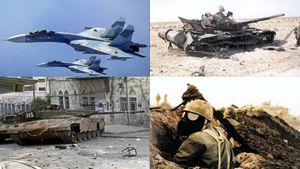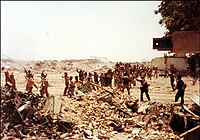Judea Crisis
| Judea Crisis | |||||||
|---|---|---|---|---|---|---|---|
 Clockwise from top left: 2 Pavulturilori Air Force Arlet Ar-85 "Paloș" on patrol, Destroyed Sconian tank, Sconian troops preparing to assault a pavulturilori position, a Pavulturilori T-85 Înger in Aktonia. | |||||||
| |||||||
| Belligerents | |||||||
|
|
| ||||||
| Commanders and leaders | |||||||
|
| |||||||
| Units involved | |||||||
|
|
| ||||||
| Strength | |||||||
| 1,000,000 | 800,000 | ||||||
| Casualties and losses | |||||||
|
| ||||||
The Judea Crisis, also called the Judea War, was a was a major war fought between Pavulturilor and Sconia which started in May 2008 and ended in November of the same year. It began with the Sconian invasion of Judea, and ended with the Battle of Aktonia. The war resulted in the overthrow of Ali Al-Nour, the caliph of the Islamic Republic of Sconia, ending the war.
The war was started as a direct result of the expansionist policy of Al-Nour's government, who sought to strengthen Sconia in the world stage, as well as his opposition for Judaism, and by inclusion, the neighboring country of Pavulturilor.
Background
History of Judea
Rule of Ali Al-Nour
Prelude
Course of the War
Invasion of Judea
On 25 May 2008, Al-Nour, declared war on Pavulturilor and launched a full scale invasion of the Judea region. The invasion overwhelmed most of the local Royal Pavulturilori Army garrisons, however, the invaders weren't able to progress further due to the inability of the Sconian Air Force to establish arial superiority over the area.
Sconian advance stalls
Despite the initial numerical advantage of the Sconian Military, many Pavulturiloris enlisted in the armed forces to defend the country from the Sconian invasion. The large amount of new Pavulturilori soldiers helped contribute to stalling the Sconian offensive. During the offensive, Sconian forces began sieging the city of Fălița; at the time, the city was the last defense before Sconian forces reached the Pavulturilori capital of Dăbuza. After one month of fighting, the siege was lifted and Pavulturilori forces initiated a counter-offensive.
Pavulturilori counter-offensive
With the Pavulturilori government negotiating its full entry to the Cooperation and Development Coalition (CODECO), it received supplies and military support against Sconia. The Pavulturilori high command created an ambitious plan to invade the entirety of Sconia in a few months, with the plan utilizing the fresh supplies received from CODECO countries, mainly Creeperopolis.
The plan was to establish aerial supremecy throught Sconia with the newly developed F-02 Sabie, as well as the Akvarelian-built Arlert Ar-85 "Paloș" air superiority fighters, and to strike ground targets with the newly acquired Creeperian-made Maroto Botín MB-25 "Topor" ground attack aircraft.
Battle of Aktonia

After four months of fighting since the beginning of the war, the frontline of the Sconian army collapsed and the Pavulturilori forces quickly advanced to the country's capital of Aktonia. The battle for the capital persisted for two months. The battle culminated in the attack on the Aktonia Palace on 28 November 2008. The palace fell at 6:00 p.m. local time and Al-Nour was captured. Later that day, Pavulturilori leaders declared that the war was over.
